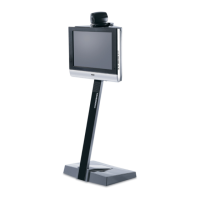
Do you have a question about the TANDBERG MXP and is the answer not in the manual?
| Encryption | AES |
|---|---|
| Data Collaboration | H.239 |
| Video Standards | H.263 |
| Audio Standards | G.711, G.722, G.728, AAC-LD |
| Network Protocols | H.323, SIP |
| Max Video Resolution | 720p |
| Connectivity | Ethernet, ISDN |
| Operating Temperature | 0°C to 40°C |
| Storage Temperature | -20°C to 60°C |
| Dimensions | Varies by model |
| Weight | Varies by model |
Learn how to activate the system from standby mode and understand the welcome screen.
Details the functions and layout of the primary parts of the remote control.
Explains the numerical keypad and call control keys on the remote.
Guides users on how to navigate through the system menus using the remote control.
Covers how to input text and numbers using the remote control's keypad.
Defines key terms used in video conferencing like Point-to-point, MultiSite, and Dual Video Stream.
Explains how to view your own image and control the camera during calls.
Details how to save and use predefined camera positions for quicker adjustments.
Describes how to use the system's screen for PC display and different layout options.
Explains how the system enters and leaves standby mode and its behavior.
Provides an overview of the various icons displayed on the screen and their meanings.
Explains the use of access codes for call restrictions and billing opportunities.
Step-by-step guide on how to initiate a call by dialing a number directly.
Details how to adjust network, bandwidth, and other call settings before making a call.
Guide on how to find and call contacts from the phone book for efficient communication.
Instructions on how to properly terminate point-to-point, conference, and MultiSite calls.
Explains how to accept or reject incoming calls and manage privacy settings.
How to block incoming calls and inform callers that you are busy.
Setting up and broadcasting your meeting to participants on the web.
How to make additional calls while already in an active call on non-MultiSite systems.
How to connect two parties and disconnect yourself from the call.
How to transfer a call to someone else without being in a video call with them.
Introduction to the phone book functionality, navigation, and entry types.
How to find contacts quickly using search features and letter input.
Methods for manually adding contacts or copying them from call logs.
How to update or remove contact information from the phone book.
Steps to create MultiSite groups for efficient conference setup by assigning contacts.
How to manage members within MultiSite groups and delete entire entries.
How to pan, tilt, and zoom both your own and the far end camera.
Explains how to use predefined camera angles and focus for quick adjustments.
How to share presentations or other video sources during a call.
Utilizing two video streams simultaneously, for example, main video and a presentation.
How to take and display still images during a call when dual video stream is not supported.
Accessing and selecting different video sources from the far end system.
Sending and receiving text messages during a video call.
Explains basic video conferencing concepts like hosts, floor control, and screen switching.
How to take control of the main screen view and assign it to other participants.
How to determine and set the video layout for conference participants.
How to view a list of all participants' terminal names in a meeting.
